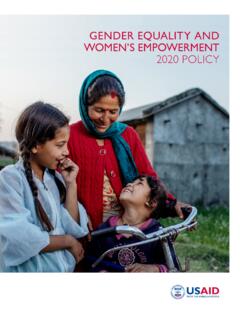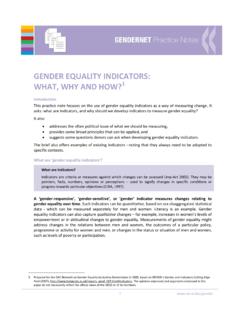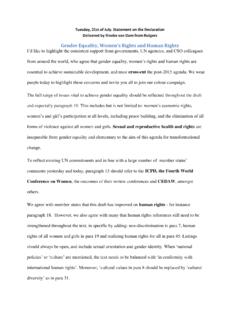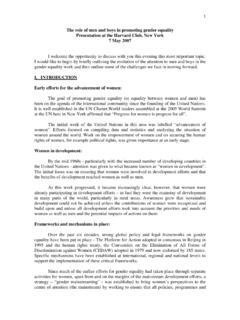Transcription of Women and Leadership - ed
1 Forum on Public Policy 1 Women and Leadership : Transforming Visions and Current Contexts Jean Lau Chin, Professor, Adelphi University Abstract Women have increasingly moved toward greater gender equality at home and in the workplace. Yet, Women are still underrepresented in Leadership roles and still considered an anomaly compared to men when in high positions of Leadership especially within institutions of higher education. In examining differences between how men and Women lead, it is often less what they do than in the different experience they face when they lead. Stereotypic gender role expectations can constrain their Leadership behaviors. Perceived incongruity between Women and Leadership roles pose obstacles to Leadership and result in double binds, more negative performance appraisals, and different standards compared to those applied to men.
2 It is increasingly clear that a gender neutral view of Leadership is insufficient, and that we need to consider the influence of cultural worldviews and socialization on shaping Leadership style. There is much to suggest that feminist Leadership styles are intentionally different-- more collaborative and transformational compared to men. This becomes more complex when we include dimensions of racial and ethnic diversity. We need to transform our views of Leadership to promote more robust theories and diverse models of effective Leadership . While current Leadership theories favor transformational and collaborative Leadership styles, organizational cultures often mirror social constructions of gender and ethnicity norms in society.
3 Within the context of higher education institutions, there is often a tension between hierarchical and collaborative forms of Leadership reflected in contradictory sets of practices. While Women leaders may have an advantage in such contexts, they also face obstacles in needing to change organizational cultures that mirror social biases against Women as leaders. Underrepresentation Women have increasingly moved toward greater gender equality at home and in the workplace. Changes in gender roles and lifestyles have occurred with men now sharing more in household chores and childrearing. Social rules of etiquette and gender roles are now more flexible and equity within the marital relationship more common.
4 Women are more able to navigate life in and outside the home easily and freely. Many Women now work outside the home; in the , they comprise 46% of the work force. So much has changed; so much has not. Women are still underrepresented in Leadership roles in corporations, institutions of higher education, and the political sector especially in light of the changing population demographics. In the , Women now make up 23% of American CEOs. Few Women reach the top in higher education although Women increasingly enter the ranks of academia. A total of 453 Women , representing 16 percent of all presidents, now head colleges and universities; their share of college and university presidencies has more than tripled in the last 20 years Forum on Public Policy 2 (Touchton, J.)
5 G. & Iomengram, D. 1995). In 2006, 86% were white and 23% were Women with the majority of Women presidents heading up small, private four year universities or community colleges (June, 2007). Women are still considered an anomaly compared to men when in high positions of Leadership . Contradictory portrayals of Women leaders pose obstacles to how they lead, and often result in different standards than those applied to men. Women leaders are alternately portrayed as soft and ineffective or domineering and manipulative . This picture is complicated by its interaction with racial and ethnic differences. Is there a difference between men and Women in how they lead? The answer to this is complex; yes and no.
6 Theories of Leadership are typically neutral or absent in their attention to gender as if a leader is a leader while studies on Leadership typically ignore gender differences or mostly study white men. Popular wisdom and Women s self-reports often identify distinct Leadership styles and characteristics associated with gender while empirical studies on gender and Leadership ( , Eagly & Johnson, 1990) often show that men and Women leaders behave more alike than different when occupying the same positions. Why is it then that the strength of these perceptions persists? We often perceive traits associated with leaders that may not have much with to do effective Leadership ; these characteristics are often embraced by leaders themselves.
7 Terms like he looks like a leader; he is presidential ; charisma, visionary, are all terms used to define leaders. They often capture what followers want in their leaders which, in turn, are influenced by social constructions of Leadership which are associated with the social construction of gender roles and their resulting impact Leadership styles. In a meta-analysis of gender and Leadership style (Eagly & Johnson, 1990), gender differences did not emerge in organizational studies between interpersonal vs. task oriented style. However, stereotypic gender differences did emerge in laboratory experiments and assessment studies, , studies when participants were not selected for holding a Leadership position.
8 Social perceptions and expectations apparently influence the Leadership styles of Women leaning toward being more relationship based when in situations of self-assessment or when appointed to Leadership roles in laboratory studies. Men conformed more toward the social stereotypes of being more task oriented, self-assertive and motivated to master their environment while Women conformed more toward social stereotypes of being more interpersonal, selfless and concerned with others. This is often distinguished as a person orientation over task-orientation with Women viewed as having an advantage (Bass & Avolio, 1994; McGregor, 1985). There is strong evidence to support the tendency for Women to adopt a more collaborative, cooperative, or democratic Leadership style and for men to adopt a more directive, competitive, or autocratic style; this emerged in all types of studies.
9 Even though selection criteria for Leadership positions may even out the gender differences, Women seem to be intentionally different and more collaborative based on differences in personality and social Forum on Public Policy 3 interpersonal skills. The use of a collaborative process is increasingly central to views of effective Leadership . Is there bias against Women leaders? People often associate qualities to leaders that are inherent in the personality of the leader. They may view leaders as inspiring followers to behave according to the purposes of the leader including: 1) a role model ( , setting an example), 2) talent in having a specific skill for the organization, 3) initiative and entrepreneurial drive, 4) charisma ( , attractiveness to others and the ability to leverage this esteem to motivate others), 5) inspirational ( , instill passion or cultivating an environment that brings out the best of individuals), 6) commitment or visionary ( , clear sense of purpose or mission-driven).
10 However, it is unclear how dimensions of gender, race and ethnicity confound these assessments of Leadership and the conferring of Leadership status. Aversive sexism and racism Eagly and Karau (2002) suggest that perceived incongruity between female gender role and Leadership roles leads to prejudicial appraisals of Women leaders. Women as leaders can be perceived as incongruous. Eagly (1987) also found that Women leaders were evaluated differently and less favorably than men even when performing the same Leadership behaviors. Thus, social perceptions and expectations often result in more exacting standards for Women and ethnic minorities than those applied to white men.














